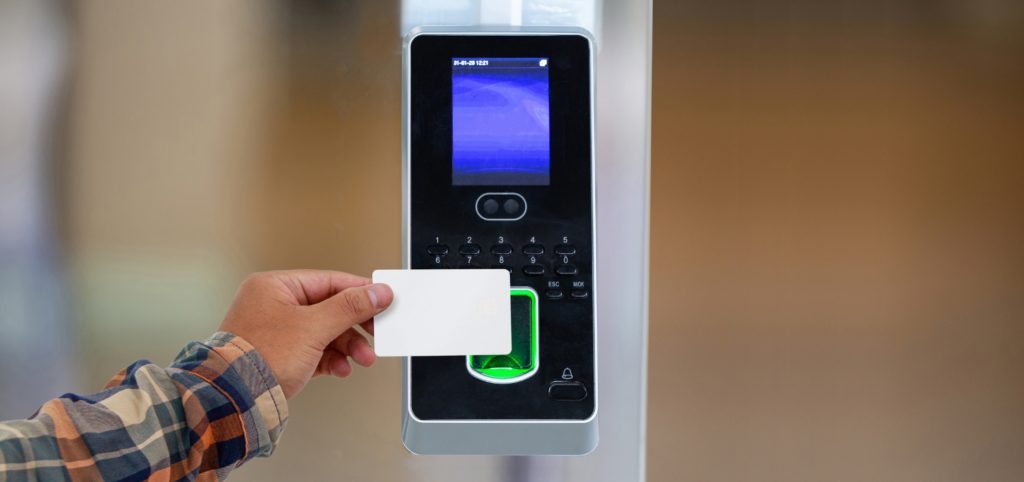
The importance of proper access control and door hardware integration cannot be overstated. In a recent industry survey of 124 business operations leaders, nearly 20% of them stated that their organizations had experienced an increase in physical security incidents. Moreover, the seamless integration of access control systems (ACS) and commercial door hardware is critical for businesses and organizations regardless of size or industry.
Integrating your access control system and commercial door hardware solutions can help you mitigate risk; however, selecting the right approach can be challenging, especially if you don’t have a set of guiding principles or a clear understanding of what you want to achieve.
To help with the process, we’ve highlighted five best practices you can follow to evaluate and implement your access control and commercial door hardware solutions.
1. Obtain Visibility Before Getting Started.
Integrating access control systems is a necessary component of an effective security program. While roughly 84% of organizations have IoT devices on their networks, over half don’t maintain the required physical security standards. Still, before you can manage your security, you need to get visibility into your environment and understand how your current security measures are performing.
For some organizations, this may be as simple as a quick survey of their security infrastructure to identify which systems are present and what type of controls they use. For others, however, gaining visibility may require more than just walking around the building and identifying the various security systems in place.
Why is Access Control Critical to Physical Security?
Access control is critical to physical security as it allows organizations to manage who enters and exits their facilities, ensuring only authorized individuals have access to specific areas. Restricting entry to sensitive zones mitigates potential risks such as theft, vandalism, or data breaches, and promotes a safe environment for employees, clients, and visitors. Additionally, access control systems can provide valuable insights into traffic patterns and the effectiveness of current security measures, enabling continuous improvement and adaptability to address evolving threats.
A well-designed and properly integrated ACS serves as the foundation for maintaining the integrity and security of a facility. Security integrators can help improve your security program’s efficiency by providing a detailed analysis of your current security infrastructure and identifying areas of weakness or improvement.
2. Separate the Seas (Software vs. Hardware)
Interesting to note that access control systems were first developed in the 1960s as a means of dealing with the issue of lost keys. Today, access control systems have come a long way and require the use of hardware and software to be fully functional. That’s why it is essential to understand the difference between these two technologies and how they are used in an access control system to evaluate the best solution objectively.
Components of Access Control Solutions
Elements of access control solutions include a combination of hardware and software elements that work together to establish a secure and efficient system. The process of evaluating and selecting the right combination of hardware and software can be a complex task, but with the right information and guidance from a professional security integrator, you can make the process easier and more effective.
Software Components
This includes any software that controls the access control system and enables it to operate. It can be installed on a single computer or a network server, depending on the size of the system. The ACS software allows the system to run and control all of the features of the system, including adding new users and granting or revoking access to certain areas.
In addition to the software, a deciding factor in selecting an access control system for your facility is choosing whether you install an on-premise or cloud-based system. The decision between these two options comes down to your budget, business needs, and IT capabilities. While most legacy systems require on-site hardware, cloud-based access control systems can be hosted on a remote server.
Hardware Components
Components of Access Control Solutions Include doors, locks, card readers, biometric scanners, etc., that provide the physical means to control entry and exit points. Regardless of the type of hardware, it is important to ensure that the measure fits in with your overall access control plan and that you review the compliance requirements that are required to ensure the equipment is operating correctly.
3. Identify Standardization Opportunities
Standardization is a key component of an effective access control strategy. The use of standards provides a common foundation for your security system, allowing for the integration of multiple systems, which can set you up for success in the future.
Standards for Door Hardware Integration Overview
The American National Standard for Integrated Door Opening Assemblies provides an excellent foundation for understanding standards for door hardware. Below is a brief overview of key benchmarks for door hardware:
- Operation: Attributes such as the force to retract the latch and force to close the door are measured to ensure ease of egress and smooth closing. The forces to open the door vary by the type of hardware. For example lever-operated locks must open with a maximum torque of 28 lbf-in.
- Durability: Building products are expected to last a long time, and builder’s hardware is no exception. For example, grade 1 integrated door hardware assemblies must pass a rigorous test through one million opening and closing cycles, including twist tests, to ensure door integrity.
- Safety & Security: Locksets are counted on to allow carefree operation to those who are authorized and to ensure a high degree of security from the outside. Several aggressive tests are specified, including a door impact test with two blows of 50 ft-lbf plus two blows of 90 ft-lbf for Grade 1.
Other important considerations including building codes, accessibility, and sustainability, must also be considered. In terms of building codes, the requirements vary by state and municipality, but generally hardware for fire doors is evaluated and listed to UL 10C by an accredited third party.
4. Select the Best-Fit Technology for Your Existing System
Selecting a technology that seamlessly complements your existing infrastructure when integrating access control systems and commercial door hardware is crucial.
Features are key to the success of any access control system, which is why you have to be selective about which features are necessary for your setup to be successful. In-demand features include:
- Remote management: Access control remote management allows you to leverage the power of the cloud to manage your system from anywhere.
- Reporting and analytics: The reporting and analytics features allow you to understand your access control system’s performance comprehensively to make better decisions about security and overall operations.
- Emergency response: Access control should support the ability to respond to emergency situations, not hinder them, which is why emergency response features are vital to your access control system. The ability to lock down a building, or even multiple buildings, should be a part of your plan and a feature you look for in any access control technology.
- Video capabilities: Data is one thing, but visual data is a powerful tool for security. Modern access control systems are often paired with video capabilities to provide a more comprehensive security solution.
- Integrations: The ability to integrate with other systems, such as security, video, and building automation systems, is vital to your overall security plan. With more focus on efficiency, cost savings, and productivity, it’s important to streamline your security systems in today’s digital environment.
5. Customize Your Access Control System to Match Your Needs
Customizing your access control system to match your specific needs is essential for optimizing security and efficiency. For example, proximity card access control systems tend to be more prevalent within warehouse environments. On the other hand, financial institutions and government offices often opt for biometric solutions such as fingerprint and retina scanners. Still, other organizations may find combining multiple access control solutions necessary to support a more complex security plan.
A customized access control system allows you to tailor monitoring features to fit your needs. For example, you may want to assign specific employees temporary access privileges while on vacation or out sick. You can also control access to certain areas based on the time of day or date.
Popular access control credentials solutions include:
- Key cards, also known as proximity cards: These cards are a common choice for access control systems because they are easy to use and cost-effective. The cards are programmed to only work when they are within a certain distance of a card reader, making them more secure than traditional keys.
- Mobile credentials: Rising in popularity due to their convenience, mobile credentials are widely used by businesses and organizations in all industries.
- Biometrics: These credentials use fingerprints, iris scans, and other unique physical characteristics to identify employees with a high degree of accuracy.
ACS & Commercial Door Hardware Integration
Access control systems and commercial door hardware are vital to your facility’s security, no matter what industry you’re in. By integrating access control and door hardware solutions into your security system, you can improve the overall security posture of your building and enhance your daily operations.
Selecting the right integrator for your access control and door hardware integration is crucial to achieving optimal security and functionality. At 3Sixty Integrated, we have extensive experience designing and installing integrated systems, including high-quality access control and commercial door hardware components from leading manufacturers, to help our clients maximize their security investment.
As a division of The Cook and Boardman Group, 3Sixty Integrated and our sister branches have over 65 years of experience offering complete security solutions, from custom doors, frames and hardware to security integration technology. Contact us today to see how 3Sixty Integrated can help secure your organization.

